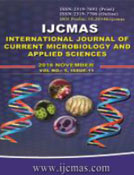


 National Academy of Agricultural Sciences (NAAS)
National Academy of Agricultural Sciences (NAAS)

|
PRINT ISSN : 2319-7692
Online ISSN : 2319-7706 Issues : 12 per year Publisher : Excellent Publishers Email : editorijcmas@gmail.com / submit@ijcmas.com Editor-in-chief: Dr.M.Prakash Index Copernicus ICV 2018: 95.39 NAAS RATING 2020: 5.38 |
Enterobiasis is the commonest intestinal helminthic disease and is long believed to be a simple illness with no important local or systemic invasive complications. A cross-sectional analytic study of 175 patients attending the surgical clinics with complaints of perianal lesions like perianal fissure, perianal fistula, perianal abscess and perianal pruritus and excoriation. Forty two (93%) of the patients in the first group had a low serum zinc (mean 7.27umol/l), this was significantly lower than the second group and the two control groups (patients with uncomplicated Enterobiasis and a normal control group), however, the mean serum level was lower than normal in these groups. After treatment of the first group with two doses of Mebendazole (100mg) at two weeks interval, 8 patients (18%) had complete cure of their perianal pathology (two anterior perianal fissure and eight pruritus and excoriation), 10 patients (22%) had a moderate response and 13 patients (29%) had a mild response. Out of 175 patients, 45 patients had enterobiasis on twice scotch tape tests. There were 34 (76%) males and 11(24%) female positive cases of enterobiasis. Perianal fissure was the most common lesion in both groups: 30 (67%) in the first group versus 96 (75%) in the second group. Perianal pruritus with excoriation occurred in 14 cases (31%) in the first group and 16(12%) in the second. Perianal fistula and perianal abscess occurred in 5(11%) and 3(6%) in the first group and in 26(20%) and 24(18%) in the second group respectively.
 |
 |
 |
 |
 |